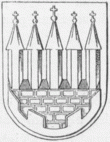Kalundborg (Kalundborg Kommune)
 |
Kalundborg is famous as the location of a large broadcasting facility, the Kalundborg Transmitter. The city was also home to the largest coal-fired power station in Denmark, the Asnæs Power Station, which started it's transition to biomass in 2017.
Kalundborg is mainly a trading and industrial town, but is also well known for its five-spired Church of Our Lady, which is closely associated with King Valdemar I and the Archbishop Absalon. The church itself is said to have been built by Absalon's brother, Esbern Snare.
Kalundborg is also the traditional seat of the aristocratic Lerche family. Their stately home, Lerchenborg, the best example of rococo architecture in Denmark, can be seen in the town's outskirts.
Ferries connect Kalundborg westward to the island of Samsø.
Kalundborg is at latitude 55°41′N, longitude 11°6′E, about 110 km west of Copenhagen on the island of Zealand (Sjaelland).
Map - Kalundborg (Kalundborg Kommune)
Map
Country - Denmark
 |
 |
| Flag of Denmark | |
As of 2013, the Kingdom of Denmark, including the Faroe Islands and Greenland, has a total of 1,419 islands above 100 m2; 443 of which have been named and of which 78 are inhabited. Spanning a total area of 42943 km2, metropolitan Denmark consists of the northern part of the Jutland peninsula and an archipelago of 406 islands. Of these, the most populated island is Zealand, on which the capital Copenhagen is situated, followed by Funen, the North Jutlandic Island, and Amager. Denmark's geography is characterised by flat, arable land, sandy coasts, low elevation, and a temperate climate. As of 2022, it had a population of 5.928 million (1 October 2022), of which 800,000 live in the capital and largest city, Copenhagen. Denmark exercises hegemonic influence in the Danish Realm, devolving powers to handle internal affairs. Home rule was established in the Faroe Islands in 1948 and in Greenland in 1979; the latter obtained further autonomy in 2009.
Currency / Language
| ISO | Currency | Symbol | Significant figures |
|---|---|---|---|
| DKK | Danish krone | kr | 2 |
| ISO | Language |
|---|---|
| DA | Danish language |
| EN | English language |
| FO | Faroese language |
| DE | German language |
















